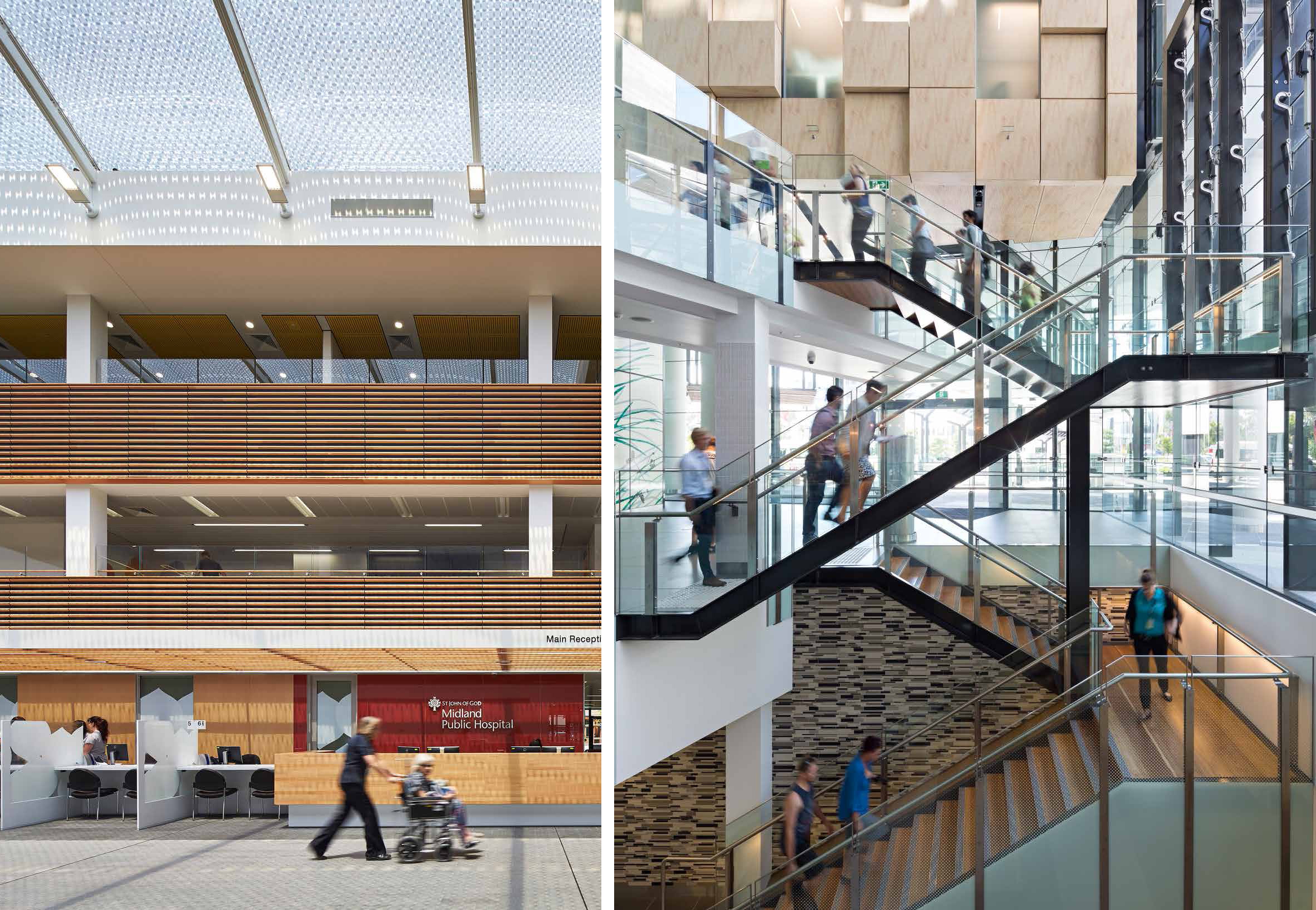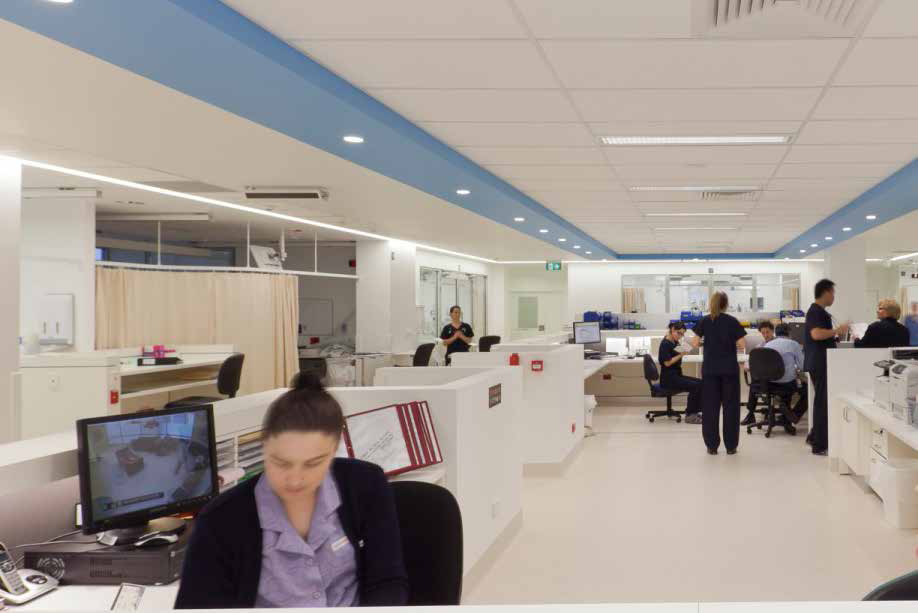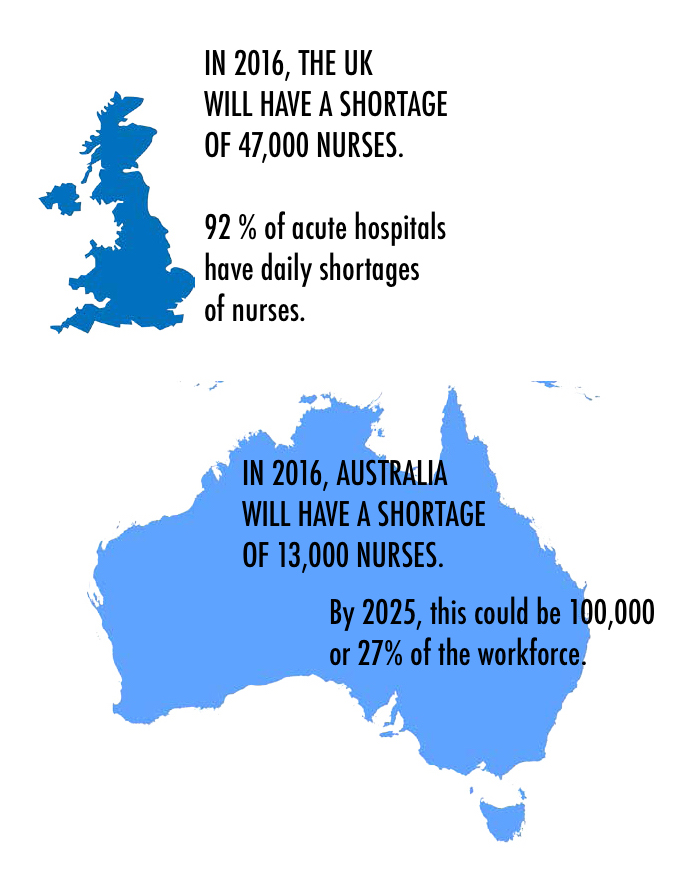
HOSPITAL DESIGN FOR NURSE ATTRACTION
AND RETENTION—THE FIRST OF A THREE-PART SERIES.
THIS IS A RESEARCH COLLABORATION
BETWEEN HASSELL AND THE UNIVERSITY OF
MELBOURNE HEALTH SYSTEMS & WORKFORCE
UNIT DR. LUCIO NACCARELLA, PROF. JIM BUCHAN
MICHAELA SHEAHAN, MEGAN READING,
DR. AGUSTIN CHEVEZ, AND BRETT POLLARD.
Click here to read the original full report.
INTRODUCTION
Nursing staff attraction and retention are currently significant issues in healthcare worldwide1 and are likely to be exacerbated by the growth in health services needed to meet the demands of the ageing global population, and as the burden of healthcare shifts to lifestyle related diseases.2 Prevailing hospital design is contributing to the difficulty of attracting and retaining nurses.
In 2015, HASSELL partnered with the University of Melbourne Health Systems Workforce Unit to determine how hospital workplace design affects nurse attraction and retention in Australia and the United Kingdom.
Previous research has identified a number of individual and organisational factors that affect the job satisfaction and productivity of nurses. While the role of the physical environment is less well understood, studies have uncovered links between hospital workplace design and efficiency, patient and staff health and safety, and staff morale.3,4
Image above (L–R): St John of God Midland Public Hospital, Western Australia;
Gold Coast University Hospital, Southport (photography by Christopher Frederick Jones).
By analysing existing research and new data from nurses currently working in hospitals, we explored elements of the physical environment that most affect nurses in their daily tasks, and how better design may be able to assist in the development of a happy and sustainable nursing workforce.
The research findings suggest that workplace design can make a meaningful contribution to a hospital’s staff attraction and retention strategy in an increasingly competitive sector.
ACKNOWLEDGEMENTS AND METHODS
Acknowledgements
This project was funded by HASSELL and a Research Connections grant from the Australian Commonwealth Department of Industry.

Photography by Peter Bennetts.
We thank the Directors of Nursing, Nurse Unit Managers and clinical ward nurses from the hospitals that participated in the research project for their time and thoughtful contributions.
HASSELL would also like to thank Dr Lucio Naccarella (University of Melbourne) and Professor Jim Buchan (Queen Margaret University, Edinburgh) for their involvement, and Professor Christine Duffield (UTS Health) for her contribution to the Advisory Group.
Note: The images within this report show HASSELL designed health facilities, not hospitals that participated in the research project, the names of which remain confidential.
Aim
The aim of the research was to identify hospital workplace design solutions to improve nursing staff attraction and retention.
Method
The project included a literature review, a series of focus group discussions, and a design response.
The literature review identified 160 articles relating to hospital nurse attraction and retention, of which 22 were reviewed. Twelve focus group discussions were held with staff from four large metropolitan teaching hospitals—two in Australia and two in the United Kingdom. The opinions of 74 nurses and nurse managers about how their physical environment related to job satisfaction, staff attraction and retention, were analysed.
In response to the findings, HASSELL explores here the potential for both subtle and bolder changes to nursing workplaces through the design process and the final built outcome.
WHAT DID WE FIND?
Hospital workplace design appears to directly influence how nurses experience their work, and indirectly influence workforce attraction and retention.
Nurses are the cornerstone of hospital care delivery.5 Yet stress, burnout, and staff turnover are common issues that undermine the ability of hospitals to provide a happy and sustainable nurse workforce.
Our research uncovered a wealth of insights into the working lives of nurses in a variety of settings.
The dedication of nurses to high quality care emerged as the participants discussed the barriers and opportunities for better workplace environments that would contribute to attracting and retaining nursing staff.
The major finding of our research is that hospital workplace design appears to directly influence how nurses experience their work, and indirectly influence workforce attraction and retention.

Design does matter
The ability of a hospital to attract and retain nurses is influenced by a complex combination of factors, including workplace design.
There are two separate, but related, issues that affect how nurses feel about their workspaces—functional design, and the symbolic expression of the value of nurses.
Nurses just want to get their work done
Poor hospital design can contribute to a culture that de-values what nurses do and how nurses work. This affects job satisfaction, and in turn, staff attraction, and retention. A perceived lack of appreciation can be countered by providing an effective, efficient, and comfortable workplace.
The three design features that matter most to nurses in their daily tasks are:
- Space to work, learn, and rest
- Proximity to staff, patients, and equipment
- Indoor environmental quality
Attraction and retention factors are not the same
Factors that influence attraction and retention differ. Attraction factors generally relate to the appearance of the workplace. Retention factors relate to how design supports workplace efficiency and effectiveness.
Good design takes time and effort from everyone
An inclusive design process coupled with a strong organisational culture can positively influence the effectiveness and longevity of a workplace’s design, and lead to more satisfied nursing staff.
DESIGN DOES MATTER
Demonstrating how highly a hospital values its nurses plays a major role in attracting and retaining the best nurses
The nursing shortage
The current and projected global shortage of nurses will be a persistent problem for many healthcare facilities.6

Centre for Workforce Intelligence 2013
The most obvious and important of these is that inadequate staffing can lead to patient health and safety issues. There is also a signifcant financial impost on health systems: the cost of nurse turnover has been estimated at up to 150 per cent of the nurses’ annual pay, depending on the type of job, level of experience, and clinical skills.7
But it is not an easy problem to solve, because despite a concerted effort over recent years to address it, the attraction and retention of nursing staff is influenced by a complex combination of factors. While pay and responsibility have significant influence1, people, teamwork, and management (collectively, organisational culture)8, and workplace design features also contribute.
Design is part of the solution, as is organisational culture.
If left unchecked, the current nurse shortage will lead to intense competition for appropriately trained staff as workers weigh job merits, including the physical design of the spaces they work in.9 Demonstrating how highly a hospital values its nurses plays a major role in attracting and retaining the best nurses. A comfortable, effective and efficient workspace is both a symbolic and practical demonstration of that value, as indicated by the comments from the nurses in our focus groups, noted in blue boxes throughout this paper.
Organisational culture is sometimes overlooked but has also been found to be a factor in nurse turnover.
“Nursing pay, although important, is not as critical to preventing turnover as is a positive workplace culture that facilitates teamwork, encourages continuous learning, accountability, trust and respect, and flexible scheduling”10
Our research explores the link between a strong organisational culture and the potential for good hospital workplace design, and finds that the careful alignment of these two factors can have a significant influence on the attraction and retention of high-quality nurses. 
References
- PriceWaterhouse Coopers (2004). The role of hospital design in the recruitment, retention and performance of NHS nurses in England. Website at http://webarchive.nationalarchives.gov.uk/20110118095356/http:/www.cabe.... n.pdf
- Centre for Workforce Intelligence (2014) Horizon 2035 International responses to big picture challenges. Website at www.cfwi.org.uk/publications/horizon-2035-international-responses-tobig-...@@publication-detail
- Ulrich, R., Zimring, C., Zhu, X., DuBose, J., Seo, H. B., Choi, Y. S., et al. (2008). A review of the research literature on evidence-based healthcare design. Health Environments Research and Design Journal, 1(3), 61–125
- Joseph, A. (2006) The role of the physical and social environment in promoting health, safety, and effectiveness in the healthcare workplace. Issue Paper #3, Centre for Health Design. Website at www.brikbase.org/content/role-physical-and-social-environment-promoting-...
- Rechel, B; Buchan, J; McKee M. (2009). Capital investment and the health care workforce. Chapter 5 (pp 85). In Investing in Hospitals of the Future. European Observatory on Health Systems and Policies. Website at www.euro.who.int/__data/assets/pdf_file/0009/98406/E92354.pdf
- Health Workforce Australia (2014)Health WOrforce Australia - Nurses Report. Department of Health Website at www.health.gov.au/internet/main/publishing.nsf/Content/34AA7E6FDB8C16AAC...$File/AFHW%20-%20Nurses%20overview%20report.pdf
- Jones and Gates (2007). The Costs and Benefits of Nurse Turnover. Online Journal of Issues in Nursing
- Ecoff and Brown (2010) Evidence Based Architectural and Space Design Supports Magnet: Empirical Outcomes JONA:40(12):505-508
- Anderson, G. (2013) Design’s Role in Attracting and Retaining Healthcare Workers, Healthcare Design Magazine Website at www.healthcaredesignmagazine.com/article/design-s-roleattracting-and-ret...
- Chan, C.CCA; McBey, K; Basset, M; et al (2004). Nursing crisis: retention strategies for hospital administrators. Research and Practice in Human Resource Management, 12(2): 31-56

